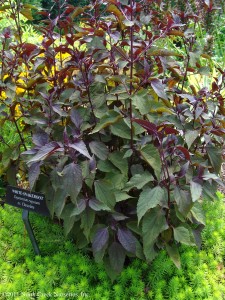White Snakeroot (Eupatorium rugosum) is native to moist woodland areas in most eastern and midwestern states (U.S.). It grows in average, moist, well-drained soil in full sun to light shade. It is a long-lived and an aggressive perennial. ‘Chocolate’ (E. rugosum ‘Chocolate’) earns its namesake for its chocolaty or burgundy tinted foliage.
‘Chocolate’ white snakeroot grows to a large, shrubby mound with dark bronze leaves and white cottony flowers in early to mid-September. The darkly tinted 4-7 inch long lance-shaped leaves lose most of their chocolaty richness by late summer. The white flower clusters average 6 inches in diameter. Inflorescence sits atop shiny dark purple stems which rise 3-5 feet in height and 1-3 feet in spread.
White snake root spreads by both vigorous rhizomes and reseeding. Deadheading of spent flowers is a must to avoid self-seeding. Self-seeding gives snake root license to become an aggressive garden thug. ‘Chocolate’ does not come true from seed (returns to its wild form).
No serious insect or disease problems. White snakeroot attracts multitudes of butterflies and bees. Flowers are an important source of nectar for transitory butterflies in late summer. White snakeroot should never be planted within reach of milking cows. A poisonous substance in white snakeroot can cause a deathly human milk sickness.
Plant Chocolate white snakeroot where it may be viewed from several angles in border plantings or in naturalized areas.


 Posted in
Posted in 
